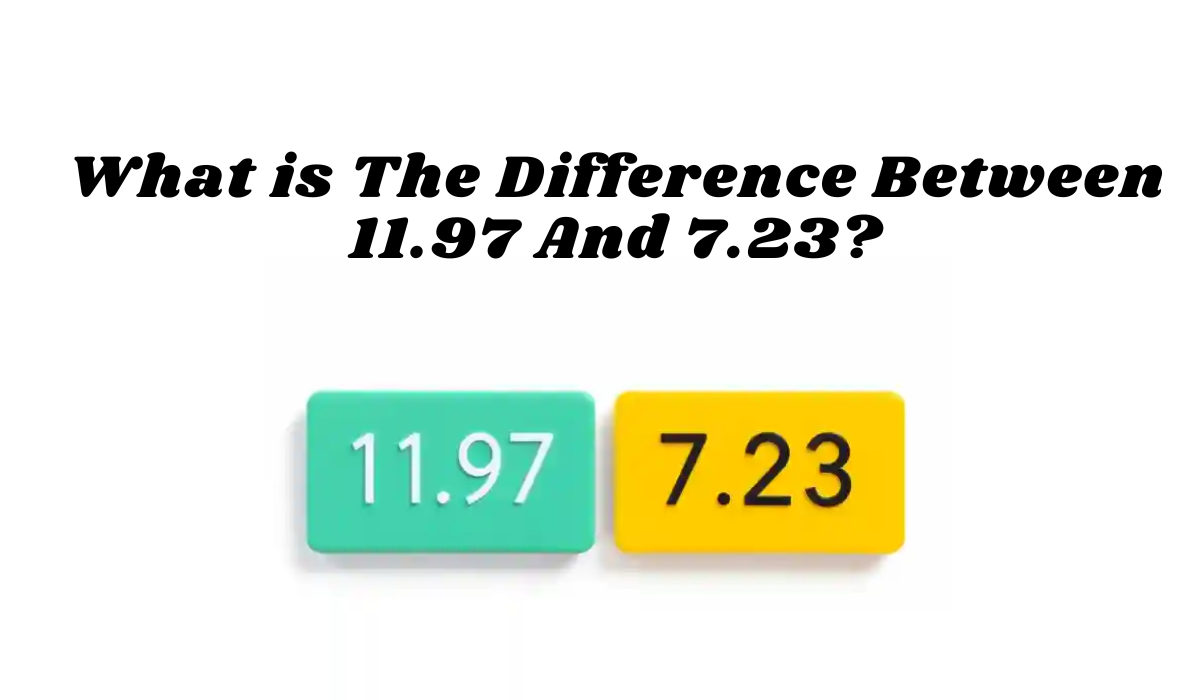Have you ever wondered how much bigger one number is compared to another, or why decimals are so important? Numbers like 11.97 and 7.23 may seem simple, but they hold many hidden insights. Whether in budgeting, measuring, or analyzing data, understanding these numbers can make a big difference.
This blog dives into what is the difference between 11.97 and 7.23 these two numbers, breaks down their components, and highlights their real-life applications. You’ll also learn how decimal places impact decisions in fields like finance, science, and everyday cooking.
By the end, you won’t just know that 11.97 – 7.23 = 4.74—you’ll understand why that difference matters.
At first glance, calculating the difference between 11.97 and 7.23 might seem straightforward. Subtract one from the other, and voilà—you have 4.74. But dig deeper, and you’ll discover that this exercise is a gateway to understanding the significance of decimal places, precision, and context.
For example:
- Imagine you’ve priced two products. One is $11.97, and the other is $7.23. The gap can help you identify profit margins or highlight pricing strategies.
- Or you’re measuring quantities in a recipe—accurate subtraction ensures flawless meals.
- Even a small difference like this can be massive when managing finances, calculating payroll, or conducting scientific experiments.
Understanding the “why” behind such differences gives you an edge in decision-making, whether you’re an entrepreneur, a student, or a hobbyist baker.
11.97 represents a decimal number typically seen across several contexts, from monetary amounts to measurements. But what does it really signify?
- Structure of 11.97:
- Tens place = 1 (10 units)Ones place = 1 (1 unit)Tenths place = 9 (0.9 or 90% of a whole)Hundredths place = 7 (0.07 or 7% of a whole)
- Finance: You might pay $11.97 for a lunch combo or subscription fee.Measurements: It could represent 11.97 ounces of flour or a temperature reading for an experiment.Mathematics: It’s a precise decimal that can affect everything from rounding to ratios.
- Breaking Down 7.23:Ones place = 7 (whole number)Tenths place = 2 (0.2 or 20% of a whole)Hundredths place = 3 (0.03 or 3% of a whole)
- Buying an item that costs $7.23Measuring distances or scientific samplesUsing it in equations, such as calculating averages or proportions
- Magnitude:11.97 is 4.74 larger than 7.23.Despite being close, the difference can be significant depending on context.
- Decimal Precision:
- Both numbers have values past the decimal point, which makes them suitable for precise applications like pricing or scientific measurements.
- Context Matters:
- The importance of this difference depends on whether you’re analyzing finances, recipes, or mathematics.
- Finance: A gap of $4.74 could mean pricing inefficiency or profit loss.Science: Measuring equipment with a deviation this large can result in flawed experiments.Day-to-Day Life: Grocery shopping or baking requires precision—for example, subtracting the wrong amount could alter your recipe.
- Compare and subtract amounts for groceries, bills, or project budgets.Example: You’re tracking total expenses of $11.97 in one category and $7.23 in another—knowing the difference helps fine-tune your spending.
- Measurements must be precise. If a recipe asks for 11.97 ounces of flour but you mistakenly add just 7.23 ounces, the result could be disastrous!
- Exact decimal placement is crucial in calculating distances, dosages, or volumes for experiments.
- Adjusting two price points (like $11.97 and $7.23) can impact supply chain decisions and profit margins.
- Suppose you’re calculating distances with miles/kilometers. The variance between 11.97 miles and 7.23 miles exactly is useful in optimizing routes.
- Precision in Finance:A loss of $0.05 might seem insignificant, but over hundreds of transactions, it adds up.Accuracy in Science:Decimal errors in measurements often cause failed experiments.Better Comparisons:Imagine comparing weights of 11.97 kg and 7.23 kg—without decimals, key differences could be lost.
While it may seem like a basic calculation, finding the difference between 11.97 and 7.23 reflects how numbers—especially those with decimals—shape our world. Whether you’re teaching math, managing finances, or measuring ingredients, grasping this concept equips you to tackle tasks with confidence.
Q1. Why should I care about the difference between two decimal numbers?
Even small differences in decimal numbers can have big impacts in areas like finance, science, or day-to-day tasks. Understanding decimal places ensures better accuracy.
Q2. How can I calculate decimal differences accurately?
Align the decimal points properly, start subtracting from the rightmost digit, and borrow when necessary.
Q3. Why do precise decimal places matter in budgeting?
Small decimal inaccuracies can snowball into larger losses, impacting budgets and profit margins.
Q4. Are decimals only important in science and finance?
Not at all. Decimals also matter in cooking, retail, education, and wherever precision is key.

